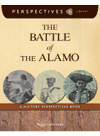Table Of ContentPage intentionally blank
THE
BATTLE
of
ALAMO
THE
A H I S T O R Y P E R S P E C T I V E S B O O K
Peggy Caravantes
Published in the United States of America by Cherry Lake Publishing
Ann Arbor, Michigan
www.cherrylakepublishing.com
Consultants: Charles David Grear, PhD, Associate Professor of History,
Prairie View A&M University; Marla Conn, ReadAbility, Inc.
Editorial direction: Red Line Editorial
Book design and illustration: Sleeping Bear Press
Photo Credits: Percy Moran/Library of Congress, cover (left), 1 (left), 4;
Bain News Service/Library of Congress, cover (middle), 1 (middle), 16;
Library of Congress, cover (right), 1 (right), 24; North Wind/North Wind
Picture Archives, 7, 9, 18, 20, 23, 30; C. Stuart/Library of Congress, 13;
Rose West Photo/Shutterstock Images, 26
Copyright ©2014 by Cherry Lake Publishing
All rights reserved. No part of this book may be reproduced or utilized in
any form or by any means without written permission from the publisher.
Library of Congress Cataloging-in-Publication Data
Caravantes, Peggy, 1935-
The Battle of the Alamo / Peggy Caravantes.
pages cm. -- (Perspectives library)
ISBN 978-1-62431-664-7 (hardcover) -- ISBN 978-1-62431-691-3 (pbk.)
-- ISBN 978-1-62431-718-7 (pdf) -- ISBN 978-1-62431-745-3 (hosted
ebook)
1. Alamo (San Antonio, Tex.)--Siege, 1836--Juvenile literature. I. Title.
F390.C27 2013
976.4’03--dc23
2013029375
Cherry Lake Publishing would like to acknowledge the work of
The Partnership for 21st Century Skills. Please visit www.p21.org
for more information.
Printed in the United States of America
Corporate Graphics Inc.
January 2014
Table of Contents
In this book, you will read about the Battle of the Alamo
from three perspectives. Each perspective is based on real
things that happened to real people who were involved in
or experienced the battle. As you’ll see, the same event can
look different depending on one’s point of view.
Chapter 1 4
.....................................................
Peter.Evans:.Texan.Commander
Chapter 2 16
..................................................
Manuel.Vela:.Mexican.Soldier
Chapter 3 24
..................................................
Ned:.Surviving.Slave
Look, Look Again 30
.........................................
Glossary 31
.....................................................
Learn More 31
..................................................
Index 32
............................................................
About the Author 32
.....................................
1
Peter Evans
Texan Commander
I
am a captain in the Texan army and one
of the commanders at the Alamo in San
Antonio, Texas. The Alamo was originally
a mission built in the early 1700s. The
missionaries there brought Christianity to
the Native Americans. Now it serves as a fort
for our Texan army in the Texas Revolution.
Today is March 6, 1836, and we have been fighting
the Mexicans here at the Alamo for 13 days.
4
The Texas Revolution can trace its roots back to
1824. That year, the territory of Texas became a Mexican
state. Most of Texas consisted of American settlers living
here on land grants from the Mexican government. We
were content to live under Mexico’s rules until Antonio
López de Santa Anna became Mexico’s president in
1833. He ignored his country’s constitution and
made new laws of his own. Mexican states were losing
their power, and we were losing
our say in the government. This
angered us. We were also far away
from Mexico City, where the Second source
government was located. We
Find a second source that
decided to rebel by trying to break discusses the reasons
behind the Texas
away from Mexico. On October 2,
Revolution. Compare the
1835, shots were fired between
information in that source
Mexican soldiers and the people
to what you read here.
of Gonzales, Texas. This was the
start of the Texas Revolution.
5
In late 1835, Santa Anna sent General Martín
Perfecto de Cós to stop our rebellion. On December 5,
Cós’s army clashed with a group of 400 Texans here
in San Antonio. At that time, the Mexican soldiers
had control of the Alamo. Cós turned the Alamo into
a fort by placing 21 cannons at the site. The Mexican
soldiers fought our army from behind its walls. But
we won. Then we moved into the Alamo. We were
hoping we could protect San Antonio from within its
walls. We needed to make sure the Mexicans did not
take control of the city. It is an important stop on the
road that connects eastern and southern Texas.
After we defeated General Cós, we tried to create
a stronger defense at the mission. Colonel James C.
Neill was put in charge of the Alamo’s defense. We
took stock of the area. The Alamo was a three-acre
complex with a large open square in its center.
Limestone walls about eight feet tall and four feet
thick surrounded the complex. On the north and
6
west sides, small buildings on the inside braced the
outer walls. A low barracks supported the southern
wall. On the east side was a two-story structure
called the Long Barrack. About 50 yards from that
building was the chapel, and at the back was the
horse corral.
The Alamo served as a mission before it became a Texan army fort.
7
Our first task was to brace the walls damaged
in our battle with General Cós. We were piling hills
of dirt to mount our cannons on when Colonel
James Bowie arrived on January 19, 1836. He carried
orders from Major General Sam Houston of the
Texan army to destroy the Alamo. After all our hard
work, the news shocked us. General Houston knew
the Alamo was a weak defense. He thought we
should retreat to Gonzales, which was roughly
70 miles east. It was easier to protect than the Alamo
and San Antonio. Plus, it could serve as an alternate
trade route. If we left, we would have to abandon
our heavy weapons. Houston did not want us to
leave arms for the enemy. His solution was to blow
up the whole mission.
Colonel Neill wanted to stay at the Alamo.
He convinced Colonel Bowie that protecting San
Antonio was critical. We could stop Santa Anna at
San Antonio if he decided to march toward Texas’s
8

